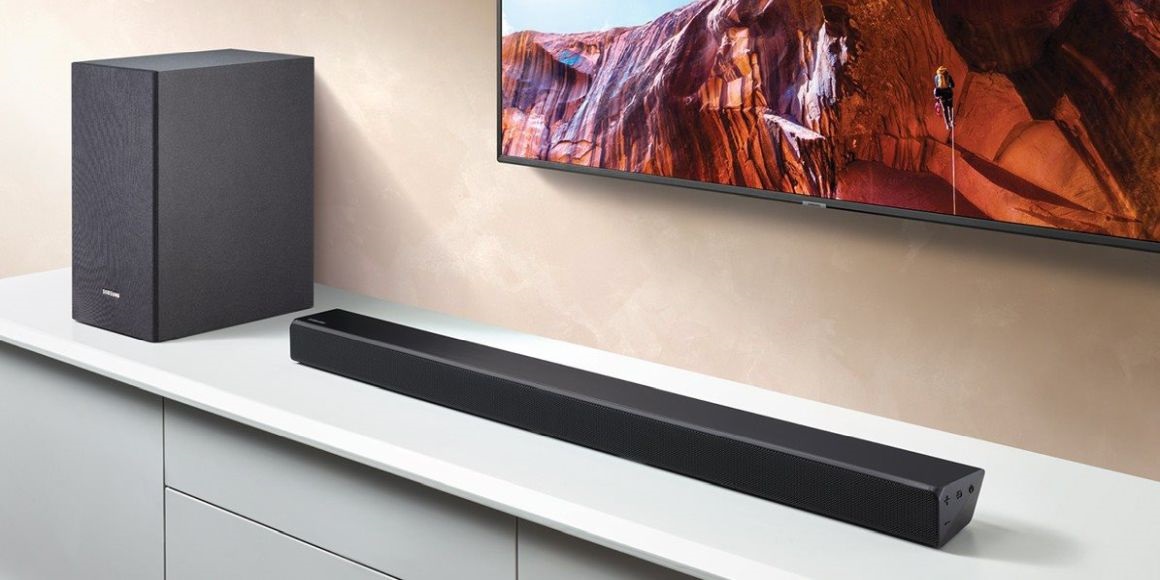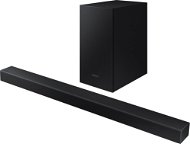Soundbars: What Makes Them Better Than Traditional Home Cinemas?
Would you like a simple and inexpensive solution how to improve your TV audio quality? A soundbar is probably your best bet. You can connect it to your TV with a single cable and start using it straight away. Even basic models provide better sound than integrated TV speakers, while the more expensive ones with surround sound can compete with traditional home cinemas. Read our article to learn everything you need to know about soundbars.

Soundbars vs Home Cinema – CONTENTS
- What makes a soundbar better than integrated TV speakers?
- How does a soundbar create surround sound?
- Do you need a subwoofer?
- Connectivity and smart soundbar features
What makes a soundbar better than integrated TV speakers?
Do you need to look into getting a soundbar? Manufacturers are making TVs bigger and bigger, but at the same time, they are getting thinner. It makes sense—this design choice makes the TV take up less space and more attractive to consumers. And while the increase in picture quality is entirely compatible with this trend, the same can't be said for audio. Small speakers simply can't generate loud and clear sound. And this is where we get to soundbars, which represent an effective and often inexpensive way to resolve this conundrum and improve your audio quality.

The name "soundbar" tells you pretty much everything you need to know about the device. It's an integrated speaker system designed primarily for TVs. Its appearance is usually designed to complement the minimalist design of modern televisions. Many soundbars for TV, usually the more expensive ones, are accompanied by a subwoofer, which is a speaker that generates sounds at very low frequencies (bass) and is indispensable if you want a truly complete audio experience. That said, sound bars are not a catch-all solution that will magically create a perfect audio system—rather, they represent a smart combo of ease of use and sound quality.
HDMI CEC: Shared control of a soundbar and TV with one remote control device
HDMI CEC (Consumer Electronics Control) is a feature that allows devices connected via HDMI to communicate with each other. This allows one device (e.g. a TV) to partially control another device (e.g. a soundbar).
We are particularly interested in this feature because it allows control of several different devices with a single remote. Theoretically, this means you could use the same remote to switch channels on the set-top box, change the volume of the soundbar and navigate through your TV menu.
In practice, however, it's a bit more complicated, as each manufacturer names and probably implements the technology in a different way. Samsung calls it Anynet+, LG calls it Simplink and Sony, for example, labels it as Bravia Sync. Therefore, seamless connection of devices using HDMI CEC is only guaranteed if you have a soundbar and a TV from the same manufacturer.
HDMI ARC (Audio Return Channel) is a mode in which the HDMI interface is able to transmit audio bi-directionally. This feature is very important for soundbar operation, as in normal HDMI mode the TV is just a playback device from an audiovisual source (such as a gaming console). But if you want the soundbar to be a playback device, you need to get the signal not to, but from the TV (to the soundbar). That's what HDMI ARC is for. HDMI ARC itself does not require the soundbar to be made by the same manufacturer as the TV.
If you want uncompromisingly high-end TV audio, you'll have to look at home theatres with true surround sound in 5.1 or 7.1 configurations instead of soundbars or build a custom system using your own speakers and receiver. However, this kind of solution can easily rob you of user-friendliness, requiring lots of cables, a good deal of DIY patience, audiophile motivation and, last but not least, a decent budget. Even a cheaper system of this type can be exorbitantly expensive by any other measure.
How does a soundbar create surround sound?
A soundbar can provide you with surround sound. It must be by definition heard differently from different angles. Home cinema audio systems achieve this by using physically positioned speakers. The number before the period indicates the number of speakers in the array and the number after the period indicates the presence of a subwoofer. In the case of the 5.1 configuration, we find three speakers in the front (right, left and centre) and two in the rear (right and left). The 7.1 systems add two more side speakers. Not surprisingly, such a system is capable of accurate surround sound reproduction. But how can a soundbar do that?
The soundbar is an active element. What does it mean?
Soundbars and their subwoofers (and sometimes other wireless speakers for surround sound enhancement) are usually active elements. This means that the amplifier is built right into their body. This greatly simplifies their interconnection and overall use.
Speakers can also be passive. In this case, they still require an external amplifier, which is a suitable solution for enthusiasts who want to have absolute control over the layout and quality of their audio system.
That's why each soundbar is also listed with the power output–this is the power of the built-in amplifier, which should match the speakers. Higher power means that the speakers should be louder, but it doesn't necessarily mean the sound will be better.

A soundbar for a TV is usually located in front and under the device, where it physically can't generate sound from the front, sides and back at the same time. Or can it? Instead of real surround sound, soundbars use so-called virtual surround sound. With virtual surround sound, the audio does come from the front-located sound bar, but its individual channels are angled differently to reach your ears from different sides. This usually takes advantage of the room's acoustics and the reflection of the sound off the walls, which turn into virtual speakers.
Rear speakers for true surround sound
As you'll see in the next chapter, an almost indispensable addition to any soundbar is a subwoofer. But rear auxiliary speakers can also come in handy. These are already included with some sound bars, while others are sold as optional accessories. Either way, they give you the opportunity to further improve the surround sound quality.
Do you need a subwoofer for your soundbar?
If you look at the soundbar range, you'll immediately notice that some soundbars come with a subwoofer and others without. The subwoofer has a noticeable impact on the sound of the whole set-up. This is because this type of speaker is responsible for reproducing sound at the lowest end of the audible spectrum—typically 20-200 Hz. In music, this is where you can hear bass instruments, while in movies, these low frequencies are what gives explosions, engine rumble, punches and so on the proper oomph. The subwoofer adds the texture and dynamics to the soundscape.

The key part of the subwoofer is the driver (its diaphragm to be precise), which moves the air to generate sound and create bass frequencies. In order for a subwoofer to reproduce these very low frequencies, its diaphragm must oscillate very slowly, but at the same time it needs to move a large volume of air. Therefore, the subwoofer must be large. For the same reason, tweeters are made small (they have to oscillate very fast). A soundbar without a stand-alone subwoofer may have clean audio reproduction, but the sound will not be as clean as it could be.
Connecting a subwoofer to a soundbar
Just like soundbars, subwoofers are very easy to connect and operate. Usually, you only need one power cable, as the connection to the soundbar is typically wireless.
If you find a soundbar without a subwoofer, it is either because of its low price or because of how the manufacturer's product offer is structured. In this case, you will find a compatible subwoofer as a separate product that you can buy later. Here on Alza, you will find some soundbars/subwoofers available for joint purchase at a discounted price. You can check out if this discount pack is available on the specific product page.
Connectivity and smart soundbar features
Soundbars are normally connected with only two cables, one to the power supply and one to the TV. This is where they have a big advantage over speaker systems—if you wanted to build a traditional home cinema with 5.1 or 7.1 sound at home, you'd have to use a lot more cables. And you'd either have to hide them away or put up with all their ugly glory. Here, you just connect the soundbar to the TV with a cable and you're good to go. You used to need optical cables for this, but nowadays it's more common to hook up the system via HDMI, because of its ability to transmit higher-quality multi-channel audio among other things.
Dolby Atmos and DTS:X
The new Dolby Atmos and DTS:X formats provide more accurate ways of capturing and reproducing the position of the audio source. For home cinema users, this mainly means more effective immersion. But not all soundbars support these formats—you'll have to pay extra if you want to enjoy a soundbar with all these fancy features. You can read all about Dolby Atmos in our article.
Dolby Atmos and DTS:X differ from their predecessors (Dolby Digital and DTS-HD) in that the sound is not pre-divided into individual channels (rear, right, etc.). Instead, spatial information is encoded in the audio file, which is only translated and divided into channels by the decoder, taking into account your specific speaker configuration. It's this ability to adapt to your home that makes surround sound so deeply immersive. And of course, sound bars benefit from it too.
Many soundbars, especially the more expensive ones, offer wireless connectivity via Bluetooth or WiFi. Thanks to this, you can use the soundbar not only with your TV, but also with your mobile phone. The manufacturer's mobile apps usually allow you to control and set up the soundbar from your phone, but music playback or podcast functions are also common. Some soundbars even come with a voice assistant, so you can use it to control your TV with voice commands.
Another notable and common feature is a software equalizer with preset audio modes. These adjust the sound to best suit the content you're playing. A movie and a news broadcast use different parts of the acoustic spectrum. Movies require good music and sound effect output, while the news must have clear and legible speech first and foremost. The wide variety of soundbar audio modes are there to make sure you get what you need.
A soundbar is a great solution for anyone who wants to expand their beautiful TV picture with great audio and avoid any extra cables. With sound bars, you can turn your living room into a home cinema with a single HDMI connection.







